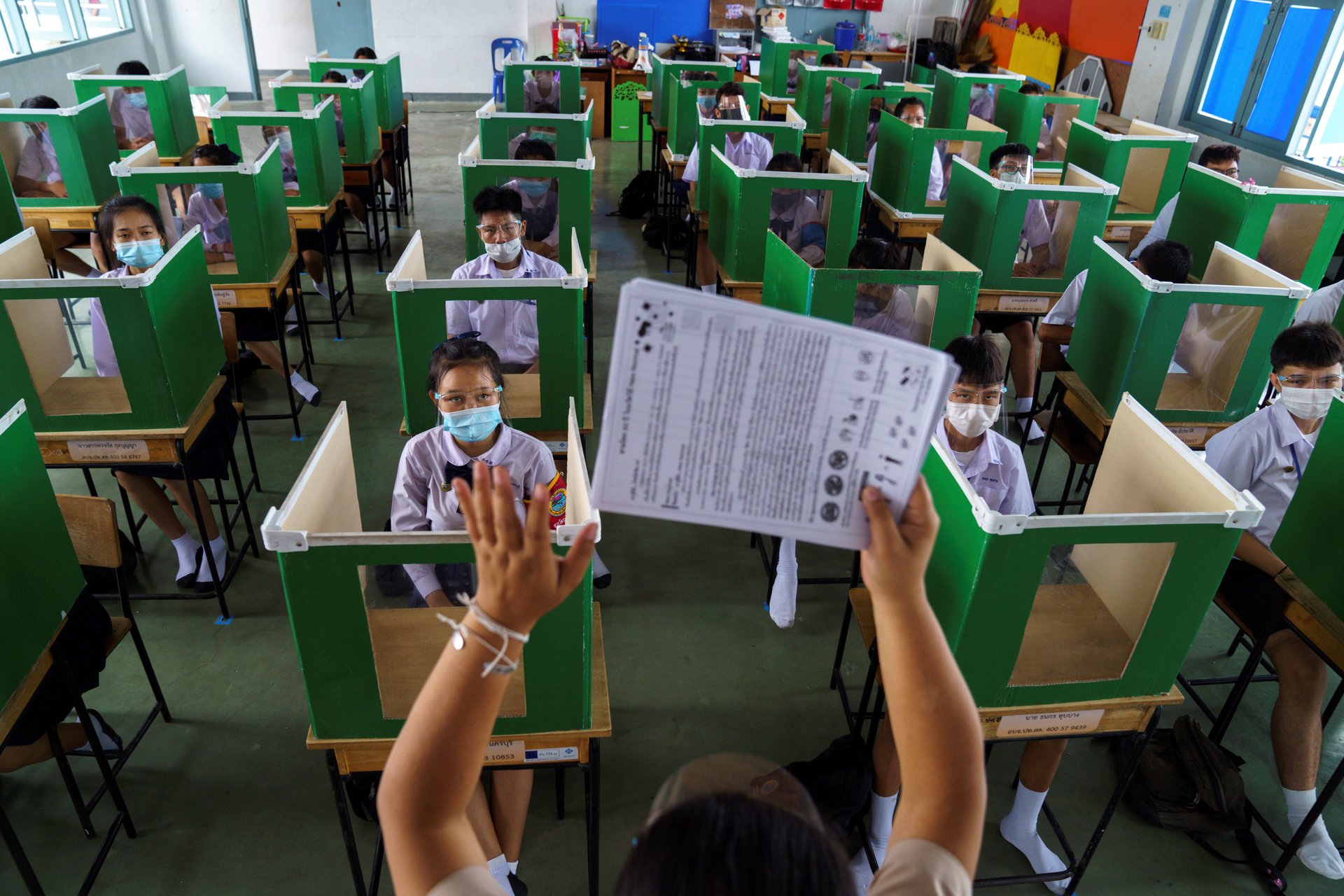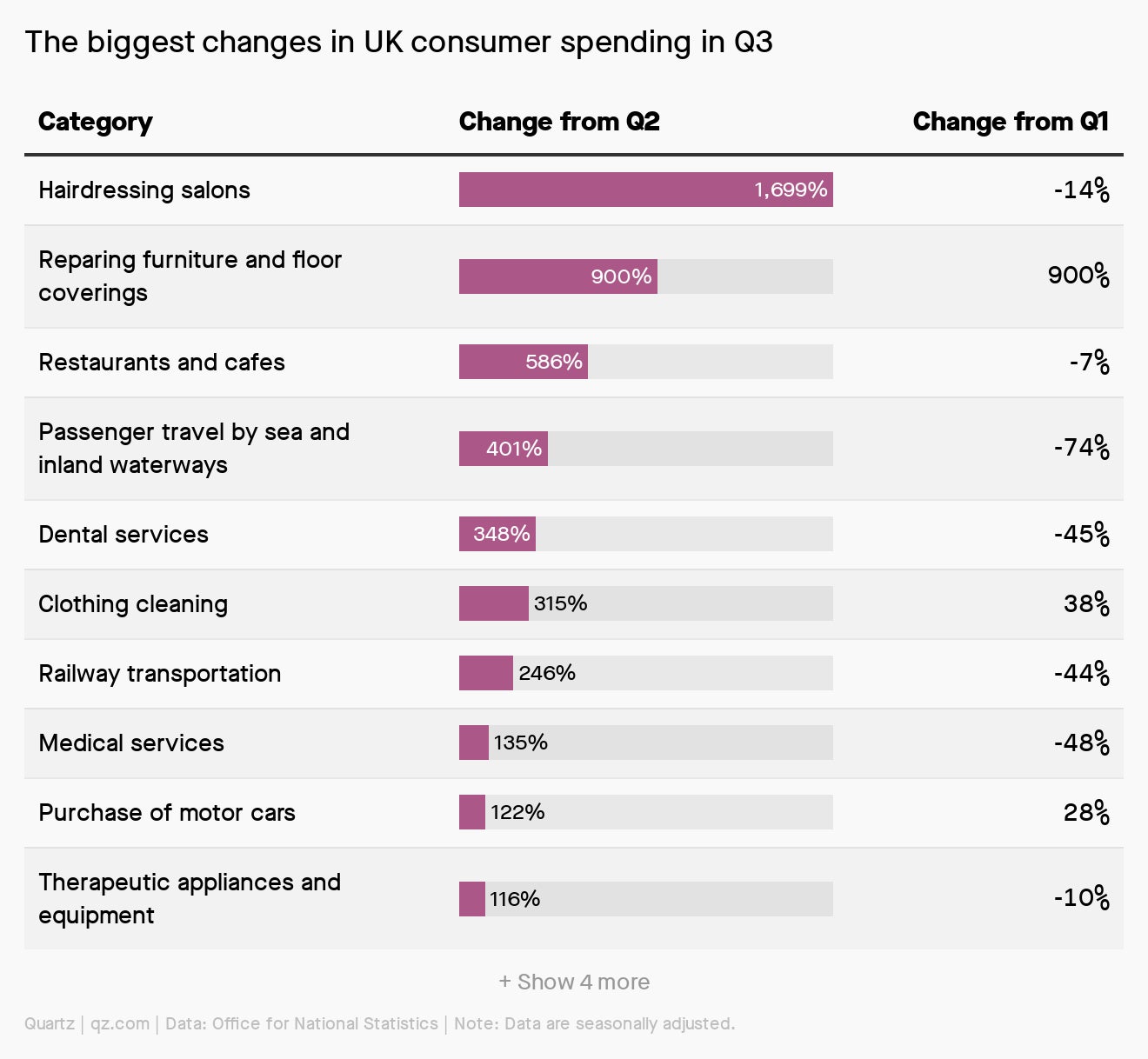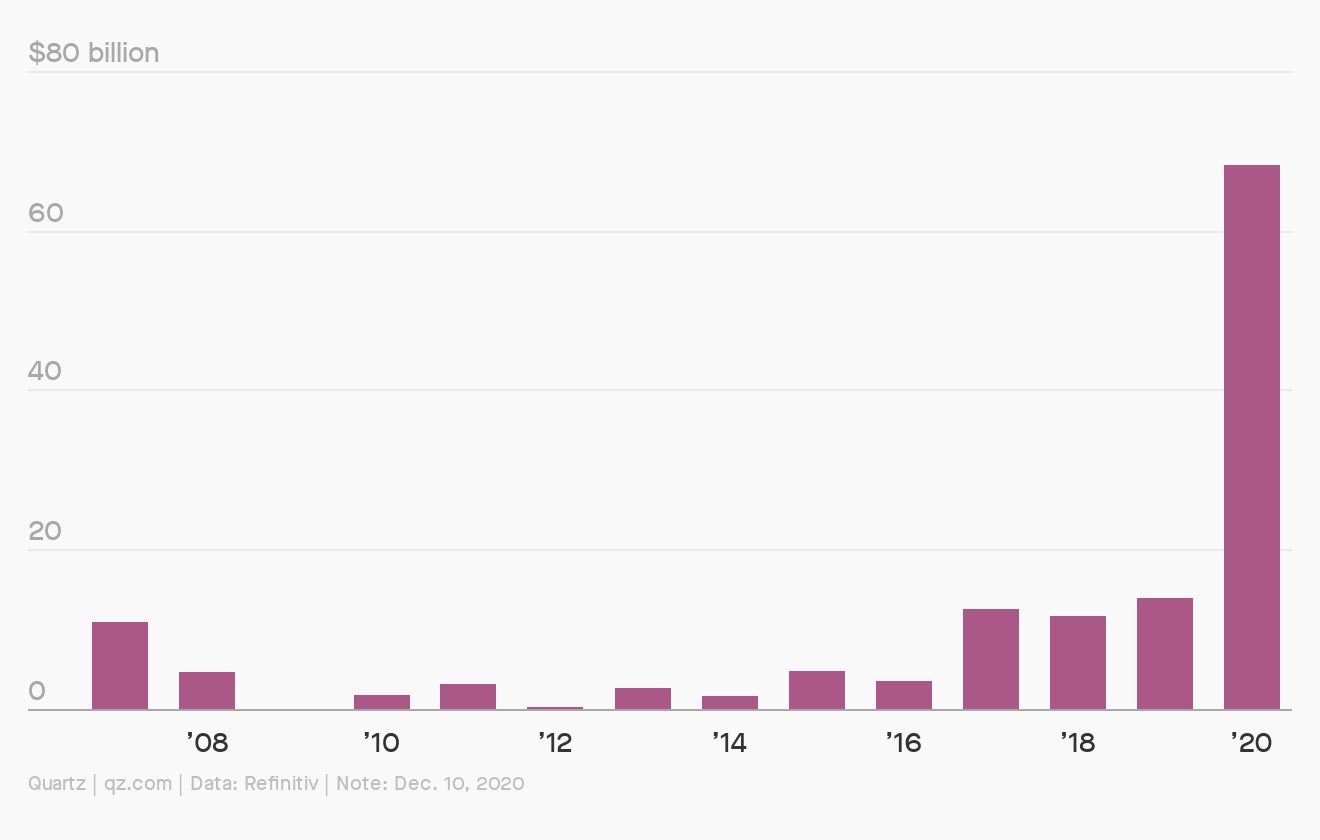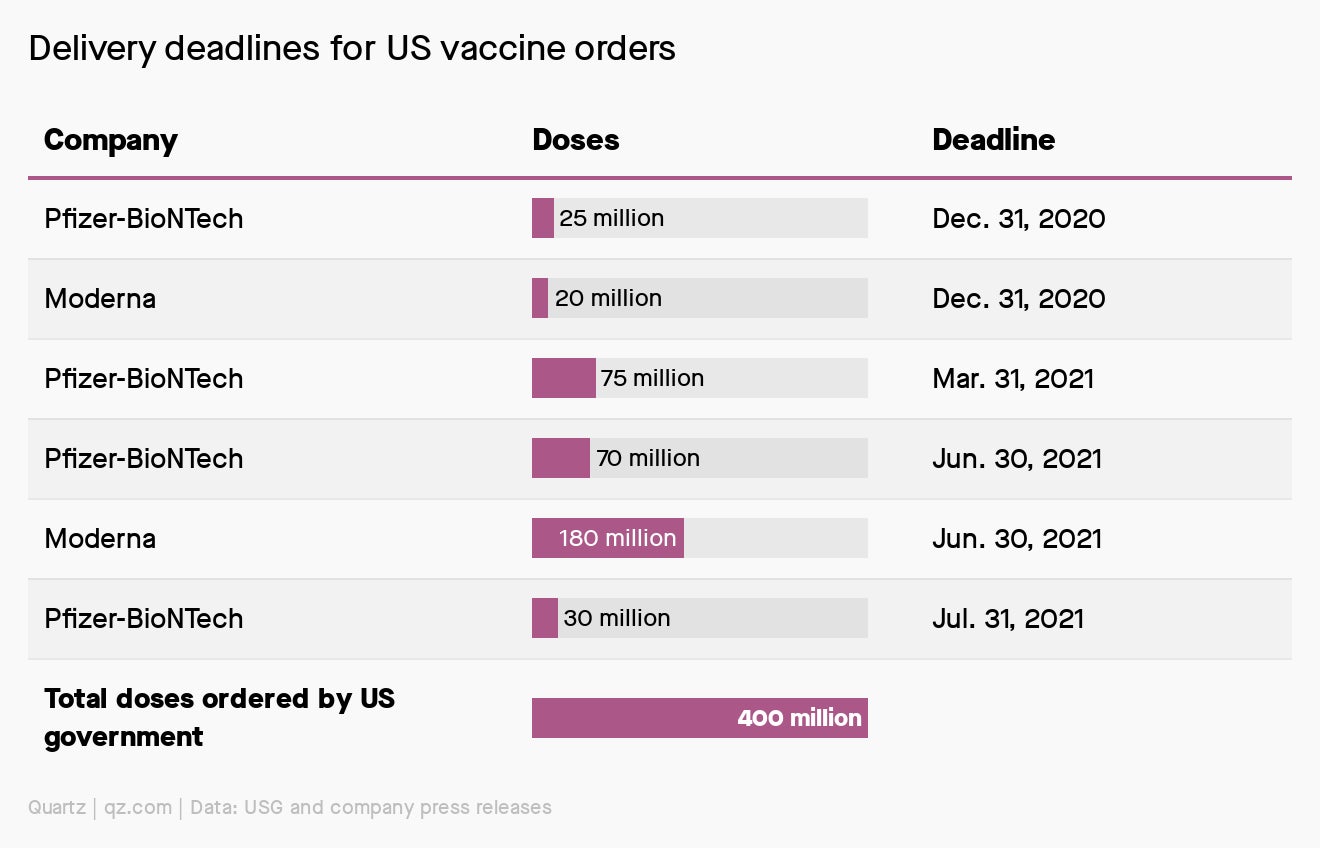Safe spaces
Hello Quartz readers,


Hello Quartz readers,
Yesterday, a vaccine candidate from Novavax known as NVX-CoV2373 (the branding needs work) became the fifth to enter late-stage trials in the West. The vaccine requires two shots, only needs to be refrigerated (not frozen), and can be manufactured using existing lab equipment, making its forward momentum particularly hopeful news for low-income countries.
NVX-CoV2373 is a protein subunit vaccine, a tried and true method that uses a lab-made version of the SARS-CoV-2 spike protein. Because these vaccines have multiple components, they typically take longer to develop. That makes it surprising that 20-year-old Novavax, which has never produced a vaccine that’s reached the public before, made it to late-stage clinical trials so quickly. Not that we’re complaining.
Okay, let’s get started.
The grand design
In a very strange way, 2020 has been a banner year for design—not styling or embellishment, but down-and-dirty solutions. At no other time have we witnessed how much the built environment has a direct bearing on our health and well-being.
As coronavirus infection rates spiked, hospital systems partnered with architects on building well-thought-out triage centers and isolation wards. MASS Design was among the first architecture firms to publish free resources on constructing spaces that limit virus transmission. “The spatial choices we make today, during this emergency, might make or break our ability to survive both this crisis and the next one,” MASS’s executive director wrote in the Boston Globe.
Making face masks also became an urgent pursuit. Contending with a global shortage, many people dusted off their sewing skills and did their DIY best. A record of these efforts is on Etsy, where makers of all caliber have sold 24 million face masks as of September. The evolution of homemade face masks is product development on warp speed—an industrial design course in action.
The same can be said about the race to multiply the world’s supply of ventilators and artificial respirators. Teams of doctors found ways to split a single ventilator to serve two patients. Ford, GE, and 3M repurposed stock car parts to produce more efficient models. Student groups took on the challenge of building medical machines from easily available parts. One prototype of a manual ventilator, made from old car parts, cost a tenth of what the typical model does to produce.
Communicating social distancing information, too, became a mass graphic design assignment. From simple directional signage to creative uses of masking tape, giant teddy bears, and cardboard cutouts, there are countless clever and often amusing examples of how to convince people to keep a safe distance. The coronavirus also made us rethink the design of our streets and public areas, reconfiguring thoroughfares once dedicated to vehicular traffic for al fresco dining, pop-up parklets, and safe recreation.
The history of design is littered with many quotable manifestos on how it can be a powerful tool for improving lives. But never before have we had such a crisis that showed us how exactly it can be done. If the calamity sandwich that is 2020 has one design lesson to impart, may it rid us of the notion that design is just about style and aesthetics.

A tale of two startups
Both Moderna and BioNTech have produced vaccines using the same revolutionary platform: mRNA, which can deliver instructions to cells to make their own target proteins for antibodies. The development will usher in a new wave of pharmaceuticals as companies capitalize on medicines made with nucleic acids and specialized delivery systems.
How this new era of drug companies will run, however, is anyone’s guess. BioNTech and Moderna are both innovative and important players in the mRNA space, but their respective paths to a Covid-19 vaccine are very different. While the former chose to partner with pharma giant Pfizer to ensure large-scale distribution, the latter opted to largely go it alone. Annabelle Timsit and Katherine Ellen Foley look at two possible paths forward as the pharmaceutical industry enters a new era of medicine.
Everyone needed a haircut
Consumer spending in the UK rebounded in the third quarter of 2020 as strict coronavirus restrictions eased starting in June. (We know now they would pick up again a few months later.) In restaurants and hotels, there was an increase of 566.3% in spending compared to the second quarter. Consumers also spent money on getting their teeth fixed, clothes cleaned, and hair…dressed.

Only a handful of categories saw significantly lower spending in the third quarter: footwear repair; newspapers, books, and stationery; major household appliances; and beer.
A special year
Speaking of spending, what trend are we charting here?

No it’s not sweatpants sales. This is the value of offerings for “blank check” companies, an alternative to traditional initial public offerings that has been the rage in 2020. These special purpose acquisition companies, or SPACs, raise money through an IPO and then go out and find acquisition targets. Similar to a direct listing, a SPAC doesn’t have a roadshow, which makes it even more pandemic-palatable.
Practicing gratitude
This year was a calamity sandwich. And yet we still discovered a few new joys. Here are some things Quartz employees want to take into a post-pandemic world:
🚴 Working out without a gym. “I used to rely on gyms for spinning, weight lifting, and yoga. Now the whole city is my gym: I’ve picked up cycling in earnest, played more tennis, and adopted more bodyweight exercises for strength training. I can’t imagine ever going back to the gym to work out.” —Katherine Ellen Foley, science and health reporter (Washington D.C.)
💒 Smaller weddings. “India capped wedding guests at 50 at some point and I have been hoping this limit sticks going forward. Sometimes, weddings in India can have upwards of 500 guests and the bride and groom don’t even know half of them. Such extravagance feels like a colossal waste of money and resources.” —Ananya Bhattacharya, Quartz India reporter (Mumbai)
⚕️ Telemedicine. “I went on a picnic, got several tick bites, joked about Lyme Disease, and then got Lyme Disease. Turns out, that’s not a big deal if you catch it very early. If telemedicine hadn’t been so easy to do, or if I’d had to go to a doctor’s office, I’m not sure I would have bothered to check out what seemed like an innocuous symptom. I plan to use telemedicine more often than I would normally have gone to an actual doctor’s office. I will also never walk through grass ever again.” —Susan Howson, email editor (Richmond, Virginia)
😎 Reading Quartz. “Without the Quartz coronavirus newsletter’s calm and informative tone, I would have set my hair on fire at least three times this year. To keep up with everything Quartz has to offer in 2021, I think I’ll take 50% off my first year of membership by using the code BYE2020. And I’ll get right on that; I have a feeling the deal ends on Dec. 31.” —All of you
You asked
How many Pfizer and Moderna vaccines did the US buy and when will they arrive?
On Dec. 23, the US government placed a second order for the Covid-19 vaccine produced by Pfizer and BioNTech, for 100 million doses. That brings total orders for the country to 400 million doses between the two shots authorized by the Food and Drug Administration—enough for 200 million people, since both the Pfizer and Moderna vaccines require two doses per person. (The US population is about 329 million.) Here’s how US orders are stacking up so far:

More orders are likely forthcoming; the government’s contract with Moderna includes an option for an additional 300 million doses, and 400 million from Pfizer. Officials also have plans to order 300 million doses of AstraZeneca’s vaccine, assuming it can assuage FDA concerns about safety and trial transparency.
Essential reading
- The latest 🌏 figures: 81.5 million confirmed cases; 46.2 million classified as “recovered;” 4.6 million vaccine doses administered.
- Big shots: The first Covid-19 vaccines have changed biotech forever.
- Pay it forward: Where to donate your US stimulus check.
- Let’s try that again: What’s different about the new PPP loans?
- Linga rona: All the medical words we learned in 2020.
- Who are you wearing?: The fundamental fashion challenge posed by staying at home.
Our best wishes for a healthy day. Get in touch with us at [email protected], and live your best Quartz life by downloading our iOS app and becoming a member. Today’s newsletter was brought to you by Katherine Ellen Folley, Anne Quito, Amanda Shendruk, John Detrixhe, Ananya Bhattacharya, Tim McDonnell, and Kira Bindrim.